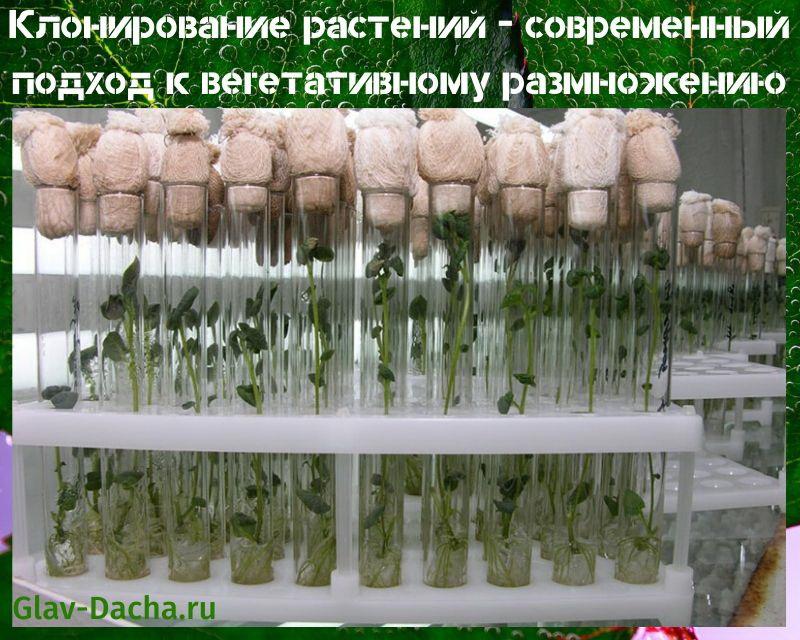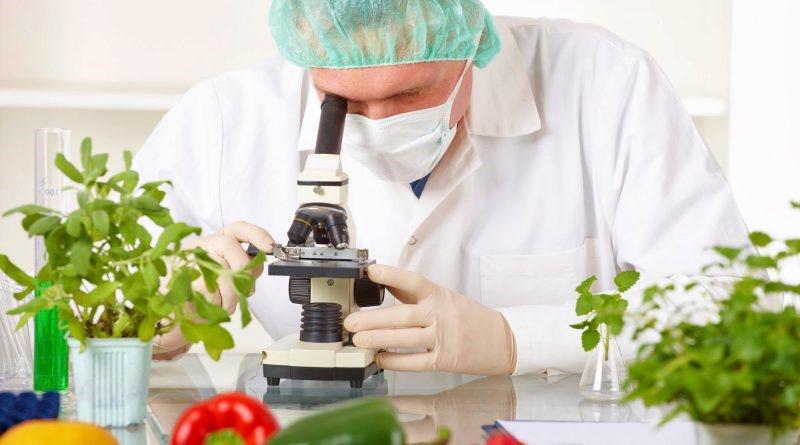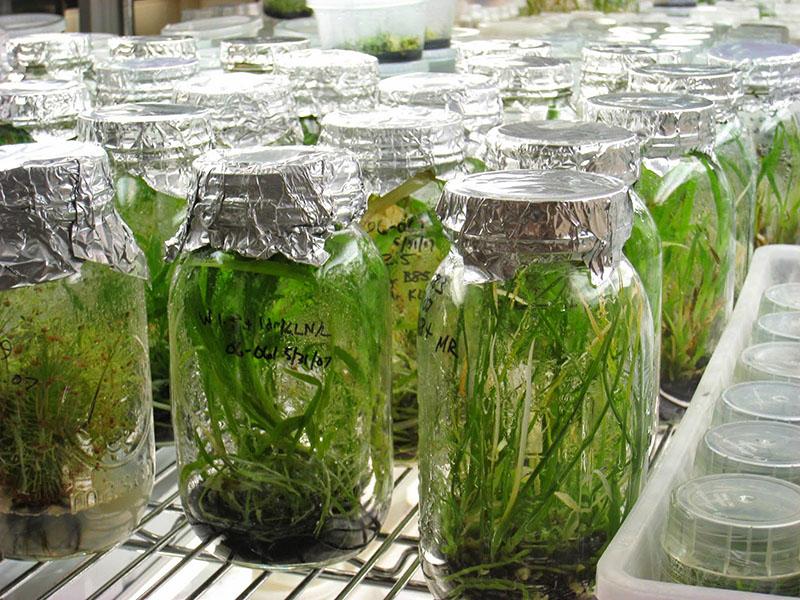Plant cloning is a modern approach to vegetative propagation
 One of the areas of biotechnology is the cloning of plants and animals. The clones obtained artificially during cell division are completely identical to the original organism. In relation to plants, cloning is a long-standing method of vegetative propagation by gardeners.
One of the areas of biotechnology is the cloning of plants and animals. The clones obtained artificially during cell division are completely identical to the original organism. In relation to plants, cloning is a long-standing method of vegetative propagation by gardeners. 
What is cloning
 The creation of organisms with the same genetic makeup is cloning. In the plant world, it is not particularly difficult, since cells continue to divide during growth and differentiation into tissues. An elementary unit of all living things is characterized by the property of totipotency - the ability to give rise to any cell.
The creation of organisms with the same genetic makeup is cloning. In the plant world, it is not particularly difficult, since cells continue to divide during growth and differentiation into tissues. An elementary unit of all living things is characterized by the property of totipotency - the ability to give rise to any cell.
The core contains genetic information, in which all data about a particular plant is fully collected. This makes it possible to reproduce an organism from a small sprout or cell, which is a clone - an exact copy of the original plant.
Cloning in nature has been going on for billions of years. In this case, plants reproduce asexually (vegetatively). The strawberry is rooted with a mustache. The same method is used by cinquefoil goose and creeping buttercup.
Blueberry forms new bushes due to lateral shoots. Of aquatic plants, the common arrowhead clones its own kind, the horizontal shoots of which spread along the bottom of the reservoir. On the coastal shoals, a water color grows, forming a mustache for procreation.
A young shoot, falling into favorable conditions, is able to take root and give rise to a new plant. For some representatives of the fauna, this is the most optimal way of reproduction, which helps to quickly disperse, preserve their range and take up new habitats.
Many plant species are listed in the Red Book: about and are on the verge of extinction. The cloning method is capable of restoring the flora.
Obtaining clones from rare plants and planting them in favorable natural conditions is one of the options for increasing their number, a chance to preserve some species.
Pros and cons of getting clones

Gardeners have long been engaged in plant cloning, as this method has a number of advantages:
- The clone is an exact copy of the mother plant, so its main features and developmental stages are predictable.
- The grower has full characteristics of the specimens obtained from the original form: the genetics of the required species (variety) is completely preserved.
- One mother plant is capable of "giving birth" to many identical seedlings in a short period of time, which makes it possible for subsequent mass plantings.
- It is more convenient to clone a variety in winter, and in spring to plant viable specimens in the ground, which quickly gain green mass, become an adult plant.
- Samples with high quality characteristics are selected, which subsequently bring an excellent harvest, have a high decorative effect or other, no less valuable qualities.

Among the shortcomings, it should be noted:
- Preservation of genetic information.In nature, rearrangements occur in the chromosome set, which in some cases is useful for the plant. It acquires endurance, resistance to certain diseases, the ability to live in changed climatic conditions and other features. When cloning, genetic rearrangements are rare.
- Grown in a practically sterile laboratory environment, clones do not adapt well in nature. Settling “in the open”, they are unable to take care of themselves. Artificially created specimens often get sick: they are attacked by pests, diseases, they do not tolerate climatic changes well.
For cloning, cells of the apical meristem (tips of shoots or tips of roots), which are capable of rapid division, are used.
A nutrient medium balanced in all components will help create nutritious nutrition for plants. When the hormonal balance is disturbed, cell differentiation stops and the growth of a shapeless cell mass or callus occurs.
Step-by-step plant cloning
 When cloning plants at home, use the required number of cuttings of the selected varieties. A healthy and productive plant is used to obtain a high yield or decorative variety. Grown in winter for subsequent planting of seedlings in the ground with desired qualities.
When cloning plants at home, use the required number of cuttings of the selected varieties. A healthy and productive plant is used to obtain a high yield or decorative variety. Grown in winter for subsequent planting of seedlings in the ground with desired qualities.
Stage 1

At the initial stage of cloning, we proceed as follows:
- we use healthy cuttings without signs of diseases;
- a young stem 10-20 cm long is cut off with a sharp, clean knife;
- cut at an angle of 45 degrees;
- the location of the stem - the place where the cuttings branch off from the shoot;
- we remove the lower leaves to enhance the growth of the root system;
- on the eve of disembarkation, we update the cut;
- we put the seedlings in water with a balanced pH = 5.8-6.2.
Roots germinate slowly in ordinary water: it will take 1-2 weeks to see the beginning of the formation of young roots. To speed up the process will help rooting stimulants, and for this the cuttings are placed in a nutrient solution.
 Let's consider how cloning takes place using rooting regulators. Biochemists have created a significant number of different stimulants. As an example: the herbal preparation Bio Roots, which enhances growth and strengthens the roots, which helps the plant to form faster.
Let's consider how cloning takes place using rooting regulators. Biochemists have created a significant number of different stimulants. As an example: the herbal preparation Bio Roots, which enhances growth and strengthens the roots, which helps the plant to form faster.
 Another stimulant option is a gel. Bioclone B.A.C. gel is suitable, as well as versions of domestic manufacturers - Hesi ClonFix and Maxiclon. In them, the cut site is lowered for several hours so that the gel gets into the inside of the stem. Then the cutting is transferred to a substrate, which is coconut fiber or mineral wool. This is a sterile environment in which the rooting process takes place. It is able to retain moisture while nourishing the roots.
Another stimulant option is a gel. Bioclone B.A.C. gel is suitable, as well as versions of domestic manufacturers - Hesi ClonFix and Maxiclon. In them, the cut site is lowered for several hours so that the gel gets into the inside of the stem. Then the cutting is transferred to a substrate, which is coconut fiber or mineral wool. This is a sterile environment in which the rooting process takes place. It is able to retain moisture while nourishing the roots.
Pay special attention to the choice of root-forming agent. It contains vitamins, hormones, and other components important for growth.
The further growth of the plant or its death depends on the choice. Contact a specialist who will tell you the best option for a particular plant culture.
Stage 2
 Rooted cuttings are placed in a hydroponic system. One option is the X-Stream 40 aeroponic propagator system. Any type of hydroponic system is not a “cheap treat,” but it pays off quickly when used properly. The grower will receive a significant number of high quality seedlings for sale or for their needs.
Rooted cuttings are placed in a hydroponic system. One option is the X-Stream 40 aeroponic propagator system. Any type of hydroponic system is not a “cheap treat,” but it pays off quickly when used properly. The grower will receive a significant number of high quality seedlings for sale or for their needs.
Clones are placed in a humidification chamber with special notches. The root system is constantly irrigated with a nutrient solution. Temperature and humidity are set one-time, and then you just need to control it.
 Once the roots are formed, it is important to create an optimal balance of nutrients so that the cuttings develop into a strong, young plant. Adequate heat and light will complete the process.
Once the roots are formed, it is important to create an optimal balance of nutrients so that the cuttings develop into a strong, young plant. Adequate heat and light will complete the process.
When cloning plants, the following conditions are created:
- Lighting throughout the day. Energy saving or fluorescent lamps with a wide spectral range are suitable. Timers for lamps are used to control the lighting time.
- The moisture level is within 80%.
- The average temperature range is + 22- + 25 ° C, but it can vary depending on the specific type of plant. The thermal regime must be constantly monitored.
Even with proper care, it is pointless to hope for a 100% result, so a significant amount of plant material must be used initially.
It is useful to place white panels next to clones. The cloning process is accelerated as the white surface reflects the wide range of colors required for photosynthesis and rooting.
Cloned trees
 Obtaining "scaffolds in test tubes" is an important task that does not belong to the category of lungs. To preserve the forest gene pool and increase it, biotechnologists are creating laboratories for growing clone trees.
Obtaining "scaffolds in test tubes" is an important task that does not belong to the category of lungs. To preserve the forest gene pool and increase it, biotechnologists are creating laboratories for growing clone trees.
For example, at the Institute of Forest of the National Academy of Sciences, in the laboratory of genetics and biotechnology, clone forests and groves are grown. Their goal is to study the necessary conditions to speed up the process of reforestation, because it takes a different time period to obtain a tree and a herbaceous plant.
Examples of cloning are on laboratory shelves. In test tubes, in vitro, there are coniferous and broad-leaved forest seedlings of different ages.
The elite shoot is divided into many parts and grown on a nutrient medium under optimal conditions:
- humidity - 50%;
- temperature - 23 ° С;
- lighting intensity - 5000 lux.
The formed seedlings go to plantations, where they are acclimatized. Such work is carried out on an industrial scale. In specially equipped, huge boxes, seedlings of deciduous and tree species are massively grown, which give rise to a large number of tree species.
The economic effect of cloning forests has been calculated. It is not only forests that provide oxygen. Aspen and birch are used as fuel, while ash, oak and linden are useful in the furniture and construction industries.
Cloning gives a chance for rooting and obtaining seedlings of rare, exotic plants. This is an opportunity to preserve the plant gene pool of the planet. The use in private farms makes it possible to use new, productive varieties that are difficult or long to reproduce in other ways. Having decided to use the cloning method, you need to weigh all the pros and cons of the process, thoroughly study it and only then get down to business.